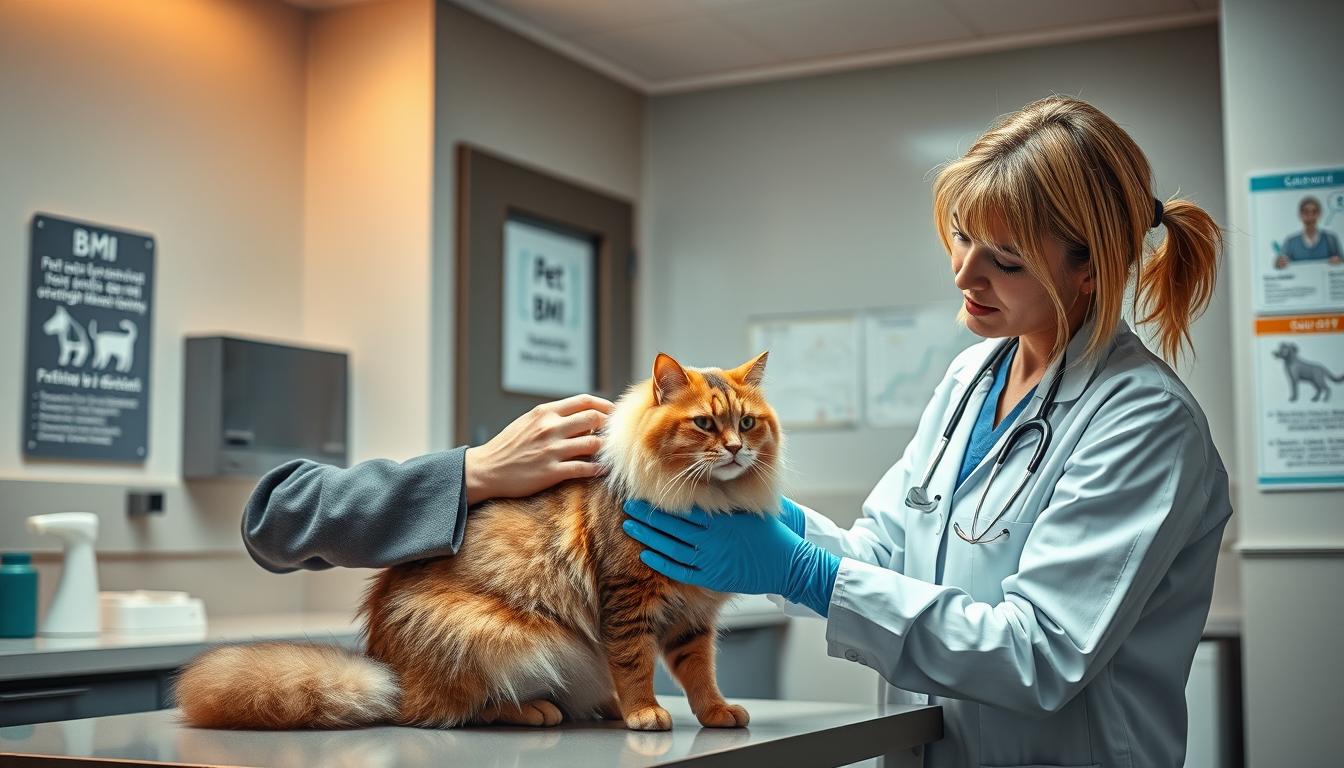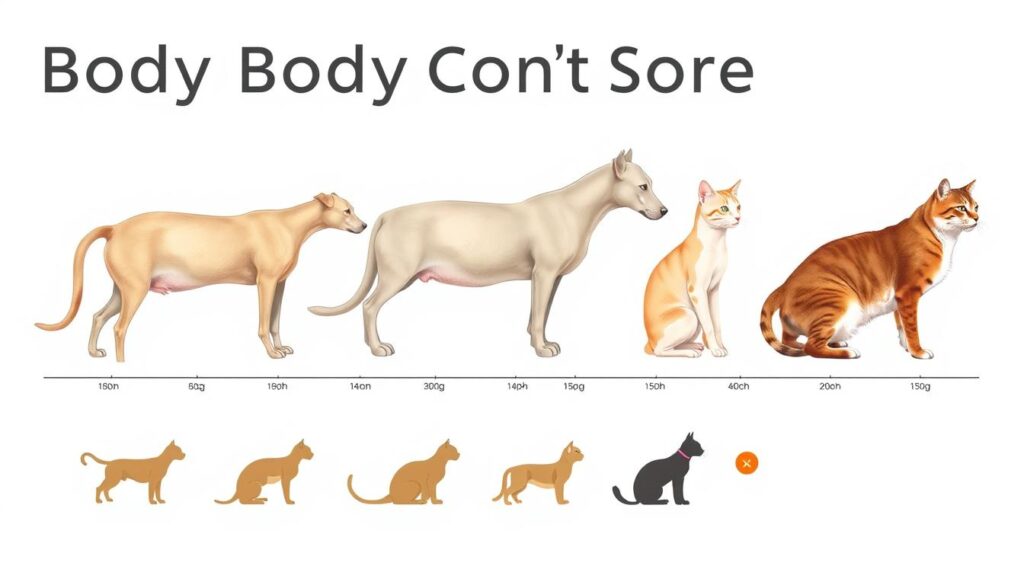“The greatest wealth is health.” – Virgil. This timeless quote resonates deeply when considering the well-being of our pets. Just like humans, pets can suffer from weight-related issues that impact their overall health and longevity.
Monitoring a pet’s weight is crucial, as excess weight can lead to various health complications. According to the Association for Pet Obesity Prevention, over 50% of pets in the United States are overweight or obese, highlighting a significant health concern.
Instead of using BMI, veterinarians assess a pet’s body condition using the Body Condition Score (BCS), which evaluates body fat percentage and composition. Maintaining a healthy weight is vital for pets’ overall well-being and quality of life.
Key Takeaways
- Monitoring pet weight is crucial for their overall health.
- Over 50% of pets in the U.S. are overweight or obese.
- The Body Condition Score (BCS) is used to assess pets’ body fat.
- Maintaining a healthy weight is vital for pets’ well-being.
- Excess weight can significantly impact pets’ quality of life and lifespan.
Understanding BMI for pets (dogs/cats) health
Understanding your pet’s Body Condition Score (BCS) is crucial for maintaining their overall health. While humans use Body Mass Index (BMI), pets require a different assessment due to their varied body structures and breeds.
What is Body Condition Score (BCS) for pets?
The Body Condition Score (BCS) is a system used by veterinarians to assess a pet’s weight status. It involves evaluating the amount of fat covering a pet’s ribs, spine, and pelvic bones, as well as the visible waist and abdominal tuck. BCS scales usually range from 1-5 or 1-9, with the 1-9 scale being more detailed and allowing for the detection of more subtle changes in a pet’s body condition.
On the 1-9 scale, a score of 4 or 5 is considered ideal body weight. Scores of 1-3 indicate underweight, while scores of 6-9 indicate overweight to obese. Using BCS, veterinarians can provide a more accurate assessment of a pet’s health than relying solely on weight measurements.
How BCS differs from human BMI
Unlike human BMI, which is calculated using weight and height, BCS is a more holistic approach that considers body fat distribution. This is particularly important for pets, as different breeds and species have varying body structures. For example, a muscular dog may weigh more without being overfat, while a cat with a larger bone structure may have a different ideal weight than a cat with a smaller frame.
BCS accounts for these differences, making it a more effective tool for assessing a pet’s body condition. By evaluating the visibility and feel of a pet’s bones, as well as their overall body shape, veterinarians can determine whether a pet is at an ideal weight, underweight, or overweight.
How to assess your pet’s body condition
Assessing your pet’s body condition is a crucial step in maintaining their overall health and wellbeing. As a pet owner, it’s essential to understand how to evaluate your pet’s weight and body condition to identify potential health risks.
Visual assessment techniques
One of the simplest ways to assess your pet’s body condition is through visual evaluation. Look at your pet from above to check for an “hourglass” figure, which indicates a healthy weight. You should be able to see a noticeable waistline behind the ribs. When viewed from the side, your pet’s abdomen should be tucked up behind the rib cage.
By regularly monitoring your pet’s body shape, you can quickly identify any changes that may indicate a weight problem.
Hands-on evaluation methods
In addition to visual assessment, hands-on evaluation is a crucial step in determining your pet’s body condition. To do this, place your thumbs on your pet’s backbone and spread your hands across their ribcage. You should be able to feel each individual rib under a thin layer of fat. This technique allows you to assess the amount of fat covering your pet’s ribs, spine, and hip bones.
“Feeling for ribs is an essential part of assessing your pet’s body condition,” as it provides a more accurate indication of their weight status.
Understanding the 1-9 BCS scale
The Body Condition Score (BCS) is a widely used system that rates your pet’s body condition on a scale of 1 to 9. A score of 4 or 5 is considered ideal, indicating that your pet is at a healthy weight. Scores below 4 suggest that your pet is underweight, while scores above 5 indicate that they are overweight.
Understanding the BCS scale is vital for pet owners, as it provides a clear and concise way to evaluate their pet’s weight status. By combining visual and hands-on assessment techniques with the BCS scale, you can accurately determine your pet’s body condition and take steps to maintain a healthy weight.
Factors affecting your pet’s weight and health
Several key factors contribute to your pet’s weight and health, going beyond just their diet. Maintaining a healthy weight is crucial for your pet’s overall well-being, and understanding these factors can help you make informed decisions about their care.
Breed-Specific Weight Considerations
Different breeds of dogs and cats have varying ideal weights due to their unique genetic makeup and body structures. For example, a large breed dog like a Great Dane will have a different healthy weight range compared to a smaller breed like a Chihuahua. Similarly, some cat breeds are naturally more muscular or have a larger bone structure, affecting their ideal weight.
Age and Lifestyle Influences
A pet’s age significantly affects their weight. Puppies and kittens require more calories and nutrients to support their growth, while older pets may need fewer calories due to decreased activity levels. Lifestyle factors such as the amount of exercise your pet gets, their living environment, and even the dynamics within a multi-pet household can also influence their weight. For instance, pets that are less active or live in environments that limit their physical activity may be more prone to weight gain.
Medical Conditions that Impact Weight
Certain medical conditions can cause weight gain or loss in pets. Conditions such as hypothyroidism, Cushing’s disease, and some medications can lead to weight gain. It’s essential to work closely with your veterinarian to identify any underlying health issues that may be affecting your pet’s weight and to develop a plan to manage these conditions.
Health risks associated with pet obesity
Obesity in pets is not just a cosmetic problem; it’s a medical condition that can have severe health consequences. Just like humans, pets can develop various diseases associated with obesity, significantly impacting their quality of life and lifespan.
Studies have shown that overweight and obese pets have shorter lifespans, with an average reduction of 2.5 years compared to pets at healthy weights. The excess weight puts additional strain on their joints, organs, and bodily systems, accelerating age-related degeneration.
Diseases Common in Overweight Dogs
Overweight dogs are at a higher risk of developing several health issues, including osteoarthritis, diabetes, heart disease, and certain types of cancer. The excess weight can also lead to ligament injuries, intervertebral disc disease, and chronic renal disease, among other conditions.
Common health issues in overweight dogs include:
- Osteoarthritis and joint pain
- Diabetes and related complications
- Heart disease and congestive heart failure
- Increased risk of certain cancers
Health Complications in Obese Cats
Obese cats face unique health complications, including diabetes, hepatic lipidosis, urinary tract disease, and mobility issues. They are also at risk of developing hypertension, gall bladder disorders, and asthma.
Many of these health conditions can be prevented or improved through weight management. By maintaining a healthy weight, pets can reduce their risk of developing these serious health issues, improving their overall quality of life.
Creating a healthy weight management plan for your pet
A healthy weight management plan is key to improving your pet’s quality of life and preventing obesity-related diseases. To achieve this, it’s essential to work closely with your veterinarian to develop a personalized plan that suits your pet’s specific needs.
The first step in managing your pet’s weight is to assess their current body condition score (BCS) and set realistic weight loss goals. For dogs, a safe rate of weight loss is typically 1-3% of their body weight per month, while for cats, it’s about 0.5-2% per month. Your veterinary team will help you calculate your pet’s daily caloric needs, which is more accurate than measuring food portions by volume.
Dietary strategies play a crucial role in weight management. This includes selecting the right weight management food, practicing portion control, and scheduling meals appropriately. It’s also important to limit treats to no more than 10% of your pet’s daily caloric intake and opt for healthy alternatives.
Exercise is another vital component. For dogs, start with short walks and gradually increase the duration and intensity. For cats, engage them in play that stimulates their natural hunting behaviors, such as using interactive toys or food puzzles.
Regular weigh-ins and body condition assessments are necessary to track your pet’s progress. It’s also crucial that all family members are on board with the weight management plan to ensure its success. Remember, managing your pet’s weight is a lifelong commitment to their health, not just a temporary solution.
By following these guidelines and working closely with your veterinarian, you can help your pet achieve a healthy weight and improve their overall well-being.


